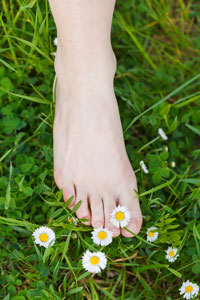Fungal infection of the feet is common, but fungus can infect anywhere on our bodies especially where there is a warm, damp, darkened environment for it to thrive in.
That can be around the armpits, the groin, the soles of the feet, and sometimes even inside the mouth & lungs.
It can also affect our nails, particularly toenails as our feet are generally enclosed in footwear. When combined with our perspiration, our shoes & socks create the perfect conditions for fungus to thrive.
When our nails become infected with fungus, it is known as Onychomycosis.
Treatments vary according to the extent and location of the infection…
There are 3 aspects that we need to consider when treating onychomycosis:
Changing the environment so that the fungus struggles to thrive, with antiperspirants, hygiene & footwear advice playing a key part in resolving the problem and helping to prevent recurrence.
Destruction of the fungus, with specific medications called terbinafine, itraconazole and amorolfine having the best scientific evidence available for successful resolution.
Delivery of any anti-fungal to the specific area where the fungus is, so that it can be as effective as possible.
It is generally the choice of delivery method that affects the success rates of any antifungal treatment, so let’s look at the options there:
Oral Treatment (tablets)
Terbinafine and itraconazole are available in tablet forms so that they can be delivered to the nail matrix from inside our bodies. There are some risks involved with this treatment option but discussion with your Podiatrist or GP will enable those risks to be managed for you. NICE (NHS) guidelines advise a minimum of 3 nail matrices infected before oral treatment should be considered.
Toenail Removal
If the nail is removed completely, and the nail matrix (that part which produces the nail) is destroyed, then there will be no nail regrowing for the fungus to infect. Alternatively, the nail could be temporarily removed so that the antifungal of choice can be applied directly to the nail bed. This removal can be surgical (eg by a Podiatrist) or chemically (eg with 40% urea cream).
Toenail Fenestration
By drilling small holes in the nail plate, any topical antifungal agent such as terbinafine spray can penetrate through to the nail bed but it is unlikely to reach the nail matrix so it is more suitable for distal (in front of the nail cuticle) onychomycosis. Care is needed when drilling these holes to avoid damaging the nail bed so look out for those who offer Clearanail or Lacuna methods of treatment.
Toenail Debridement
Removal of as much fungal nail as possible will increase the efficacy of a topical antifungal agent such as amorolfine paint (other topical treatments are available but their effectiveness & safety is debatable). This debridement can be done by filing (eg with a Dual Foot File or Diamond Deb File), drilling and/or “shaving” the nail plate and is something that Podiatrists can perform for you.
Photodynamic Therapy
Light itself has the potential to destroy fungal cells, and the use of treatments such as PACT or laser therapy is an option. However as with many of the above, they take time to be effective with repeated treatments being required and success levels are variable.
Please note that some treatments or delivery methods may not be suitable for you depending on your medical status. It is therefore always worthwhile seeking professional advice, so find a Podiatrist here.
